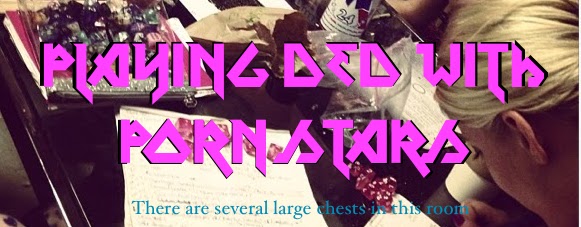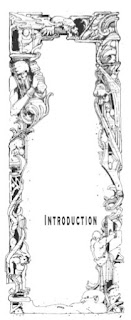Here is a pair of entries for the Thought Eater DIY RPG Essay Tournament.
If you're new to the contest, it's like this: these two essays are not by me--they're by a pair of anonymous DIY RPG writers who were both assigned to write something interesting and original about hoary old RPG topics.
Anybody reading is eligible to vote for which one you like best and voting will be cut off once all the votes for all the second round Thought Eater essays are up...
The rules for the second round are here.
First One
If you like this one better, send an email with the Subject "TAS" to zakzsmith AT hawt mayle. Don't put anything else in the email, I won't read it.
First One
If you like this one better, send an email with the Subject "TAS" to zakzsmith AT hawt mayle. Don't put anything else in the email, I won't read it.
Challenge: "Say something original about a movie that's RPG-relevant”
A character fools his overseers, sneaking out of their keep and shucking his responsibilities. He meets up with the second party member, and together they disguise themselves to persuade the master of a local dungeon to release their third party member. The newly united party escapes via a rare and valuable mount, then explores a sprawling city: they ascend its largest monument; wander through its inscrutable market; hobnob (under fake identities) with the rich; witness a sporting spectacle; and interact with strange and hypnotic artifacts. Leaving the city, they’re nearly caught by the first character’s overseer, but they stealth and perform their way out of trouble. Inter-party bickering leads to the first PC to critically succeeding on a performance check to crash a huge and elaborate parade. After the misuse of the party’s mount, the second character falls under a paralysis spell, and the party ties to dispel the magic. Meanwhile, malicious NPCs seek to imprison the party once more…
There are few films that mirror the structure of D&D more than Ferris Bueller’s Day Off.
Ferris, Cameron, and Sloane are roguish types, challenging authority, fucking things up, and generally having a good time while endangering themselves and others. Ferris Bueller’s Day Off is about retaking youth from the corrupt institutions that attempt to prematurely snuff it out; ifFerris Bueller’s didn’t have a Hollywood runtime, it’d be a pure picaresque. Ferris dances with the dangerous consequences of his spontaneity and curiosity while gaming the systems that constrain him—sound familiar?
So how can Ferris Bueller's help us better understand D&D?
From a DM’s perspective, Ferris Bueller’s is useful in that it reveals the starkest difference between a Hollywood picaresque and a D&D picaresque: things kill and get killed in D&D. Ferris didn't encounter parties of blood-smeared raiders or corpse-roasting orcs in every new location; Cameron, in destroying his master’s extremely valuable mount, exposes himself to the most risk. This is an obvious point, but it contains a useful trick: if your game is feeling too charming and neatly causal—if your game is feeling to safe—then slaughter someone. Use indiscriminate death to surprise and scare your players.
Ferris Bueller's also makes this point clear: unless you're incredibly charming, you need cash to survive new territory. Murderhobos in a big city should get jailed or executed—and quickly—if they're both poor and uncharismatic. A surefire way to encourage your PCs to get loot and get clever is to try to crush them in the gears of a big, ruthless system.
Ferris Bueller’s shows, too, that the potently dramatic moments arise when players save each other. So make sure to put your PCs in situations in which they need to save each other from imprisonment and death.
John Hughes reportedly wrote the film in a trance, finishing the first draft in a week. He wanted to "capture as much of Chicago as I could. Not just in the architecture and landscape, but the spirit." Replace Chicago with your latest setting, and that’s the prime goal for world-building via text and images. Communicate as much of the spirit of the place to your players as quickly and elegantly as possible; “this place feels like this” is often more helpful and imaginative as “this place looks like this”.
John Hughes also said: "I know how the movie begins, I know how it ends. I don't ever know the rest, but that doesn't seem to matter. It's not the events that are important, it's the characters going through the event. Therefore, I make them as full and real as I can. This time around, I wanted to create a character who could handle everyone and everything.” Whether your PCs admit it or not, they live in series of experiments and fucking-offs; whether your players admit it or not, they want their characters to be as capable, spontaneous, and daring as Ferris (or as weird as Cameron). If your players aren't having much fun, invite them be Ferris, then chase them with some snarling consequences.-
-
-
-
-
-
If you like this one better, send an email with the Subject "BOR" to zakzsmith AT hawt mayle. Don't put anything else in the email, I won't read it.
H.P. Lovecraft, it turns out, was a pretty shitty prophet of the human mind.
That's not to say he was a shitty stylist, or a shitty fantasist, or even a shitty writer overall. Mileage will vary on those questions, of course, but one thing few of Lovecraft's readers will dispute is that he was pretty shitty at characterization.
His protagonists are, for the most part, interchangeable and indistinguishable, wooden caricatures of real humans. In some ways, that's a feature rather than a bug of his work, because it can allow a reader to more easily insert him- or herself (let's face it, though -- usually him-) into the protagonist's shoes.
But it's also a consequence of the fact that Lovecraft just didn't understand humanity very well. In fact, he was dead wrong about the way our minds and souls work.
The central theme of Lovecraft's stories is that understanding of the true nature of reality would drive men mad. The universe is not only queerer than we imagine, to quote ole Einstein, but it is queerer than we can imagine.
In H.P.'s day, human knowledge of the universe -- especially of the very large and the very small -- was expanding by leaps and bounds. Everything was baffling and defied common sense. The idea that the universe was made for man, that our species was the headliner at the gig, was being undermined almost daily.
Lovecraft predicted that truly grasping our own insignificance in the face of such cosmic grandeur would lead us down a road to madness, and a sort of twisted enlightenment.
And he was dead wrong about that.
As with most new things, humans looked upon the face of the Great Mystery, and shrugged. It was cool and interesting for about five minutes, and then it was banal.
The human psyche didn't deteriorate with the realization that our species is irrelevant to the universe. Civilization did not fall into decline after discovering that the subatomic world makes no sense to us.
We just let the expert use that knowledge to make new toys.
This implies we'd do the same thing with knowledge of the Mythos. And that can make the Call Of Cthulhu game a lot more interesting.
Running Call Of Cthulhu As If Lovecraft Was Wrong
Screw Sanity points. Throw them away.
Mythos tomes grant Cthulhu Mythos skills points, just as taking a course in physics gives you skill points in that field.
But studying subatomic physics doesn't drive people mad, even though the realities of the quantum world are bizarre. Why should knowledge of rituals that bend space-time and send us to non-Euclidean landscapes be any different?
Mere knowledge never drives people mad. Never. People develop mental illnesses from severe trauma, or prolonged abuse, or chemical imbalances in their brains.
Never from just knowing shit.
The problem with Mythos knowledge is that it's been hoarded by demagogues and debased cult leaders, for their own aggrandizement.
The invesigators' job is to wrest that knowledge from the "wrong hands" and use it if not for good, then for more practical purposes. Warfare. Medicine. Entertainment.
Sure, Cthulhu's gonna wake up and eat us all, someday. The climate's gonna blow up in our faces one day, too (probably long before Cthulhu awakes), but you won't find most people losing sleep over it.
That's not to say that the Mythos isn't dangerous. Starving bears, hurricanes, and volcanoes are all dangerous, too. Two of them are unstoppable, and the best we can do is flee.
But they don't drive us mad.
If all of this is starting to make Call Of Cthulhu sound more like a game of fantasy heroics or scientific can-doism, that's on purpose. I mean, its game engine is pretty serviceable and has a nice "old-school" feel that's stood the test of time.
But its central conceit, Lovecraft's central conceit -- that knowledge of our insignificance before the grand and terrible cosmos would cast us into depths of madness and despair -- is, frankly, bullshit.
Mostly, that knowledge just bores people because they don't see its relevance. Show them how that knowledge can produce cool new toys, and they're a lot more interested.
Make your CoC game about that. About making the world better by using the Mythos in better ways. The looming threat of the Old Ones awakening makes a nice thematic backdrop, just like climate change, but if "The Shadow Out Of Time" is to be believed, its not an imminent threat in 20th or 21st centuries.
Unless somebody messes up and blows an incantation. In which case, you need to call in the experts -- Mythos magicians who are better at it -- and not the rank amateurs that Sanity points guarantees most investigators will remain.
That's why Hellboy is way cooler than Randolph Carter.
So, screw Sanity points. Lovecraft was wrong. Game like it.
-
-
-
-






























